Lecture notes written by Albert Jacka VC

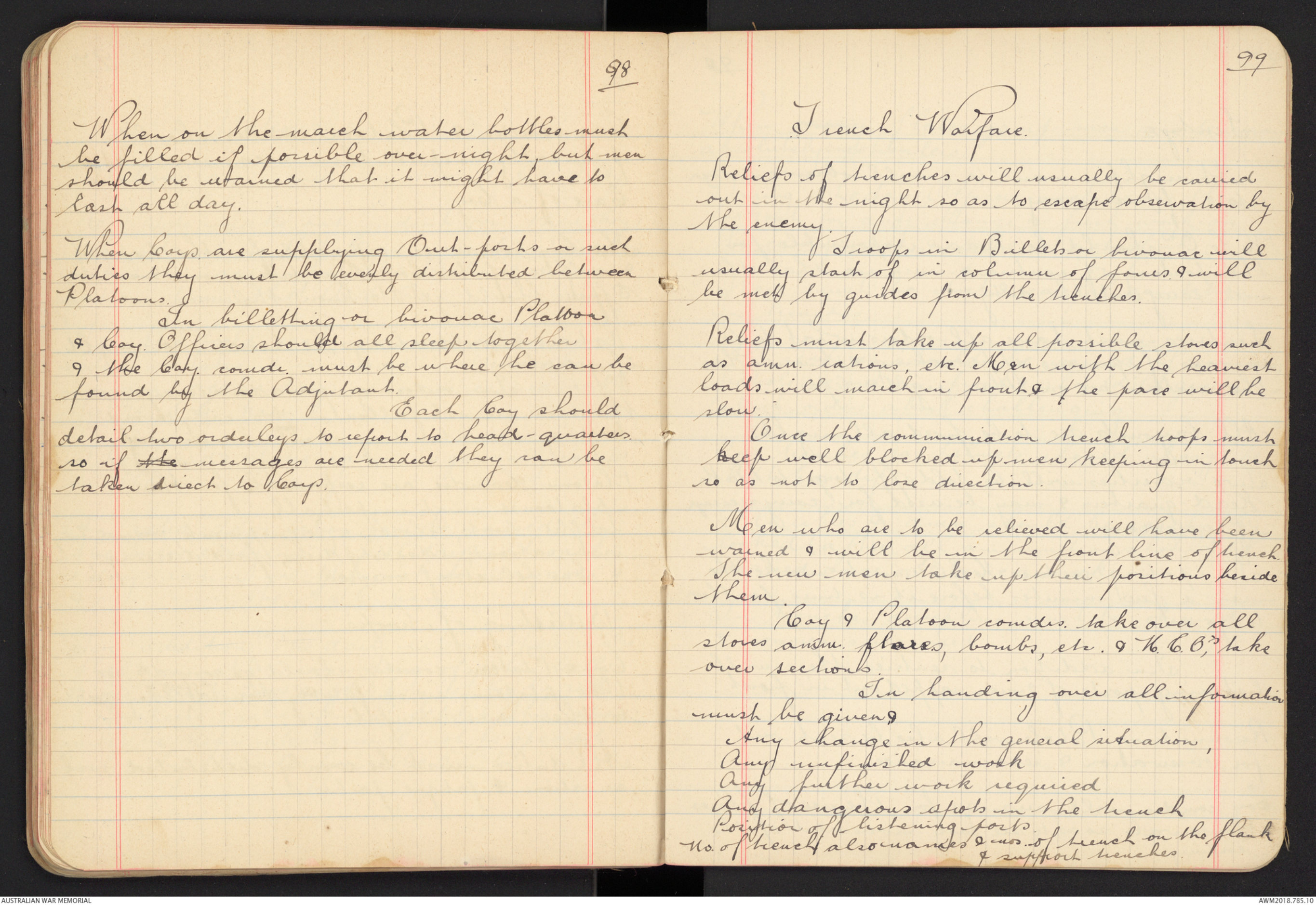
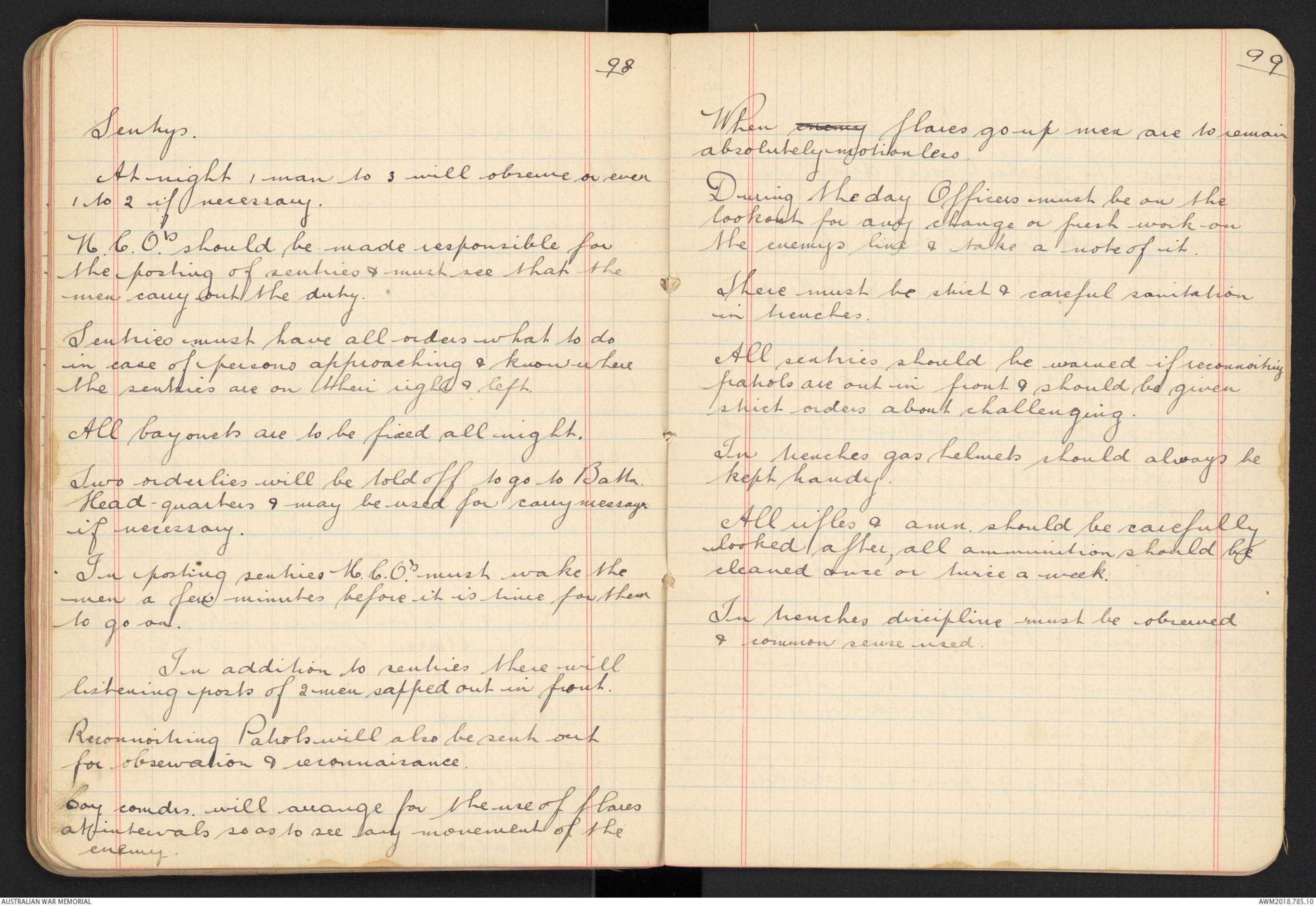
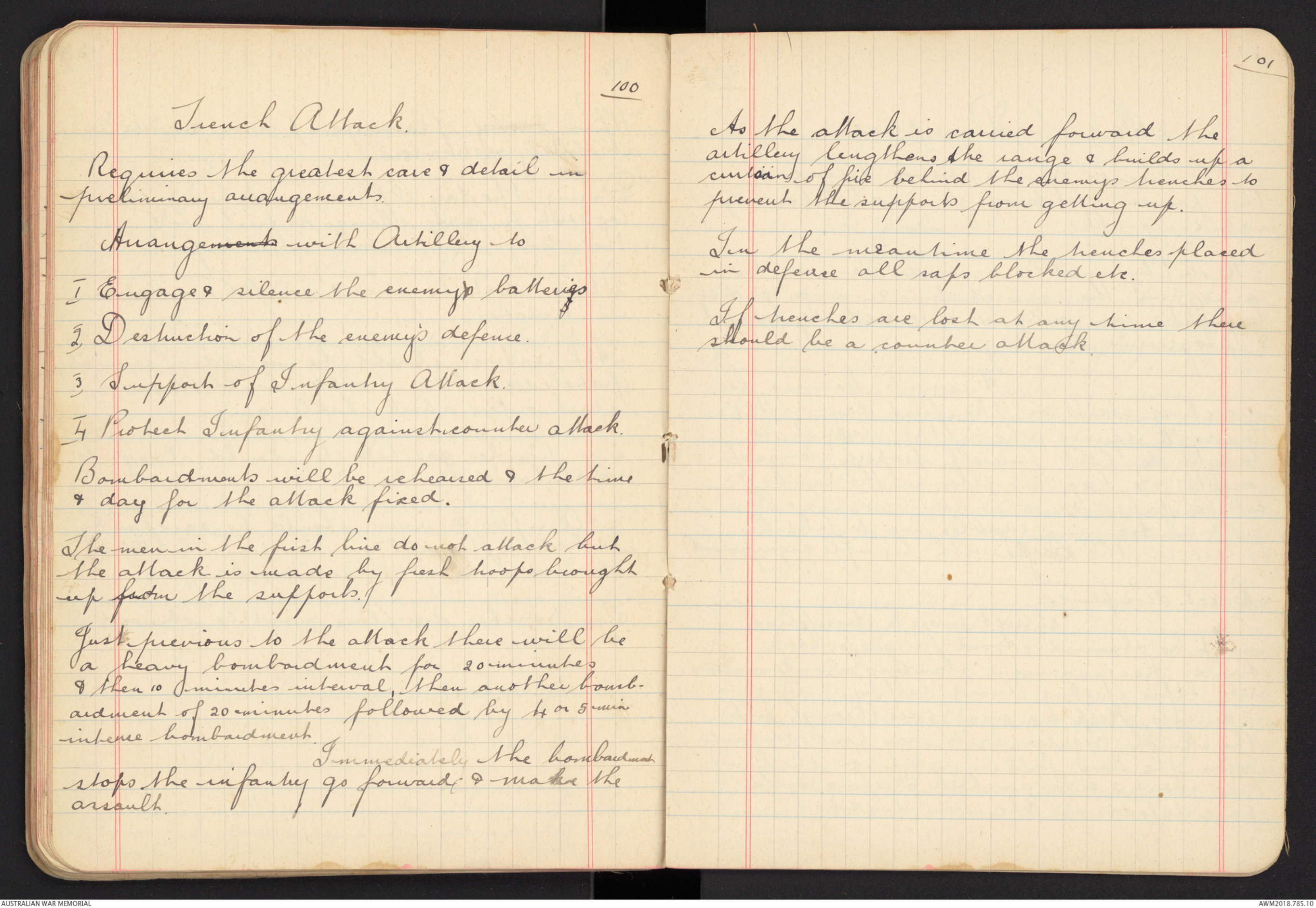
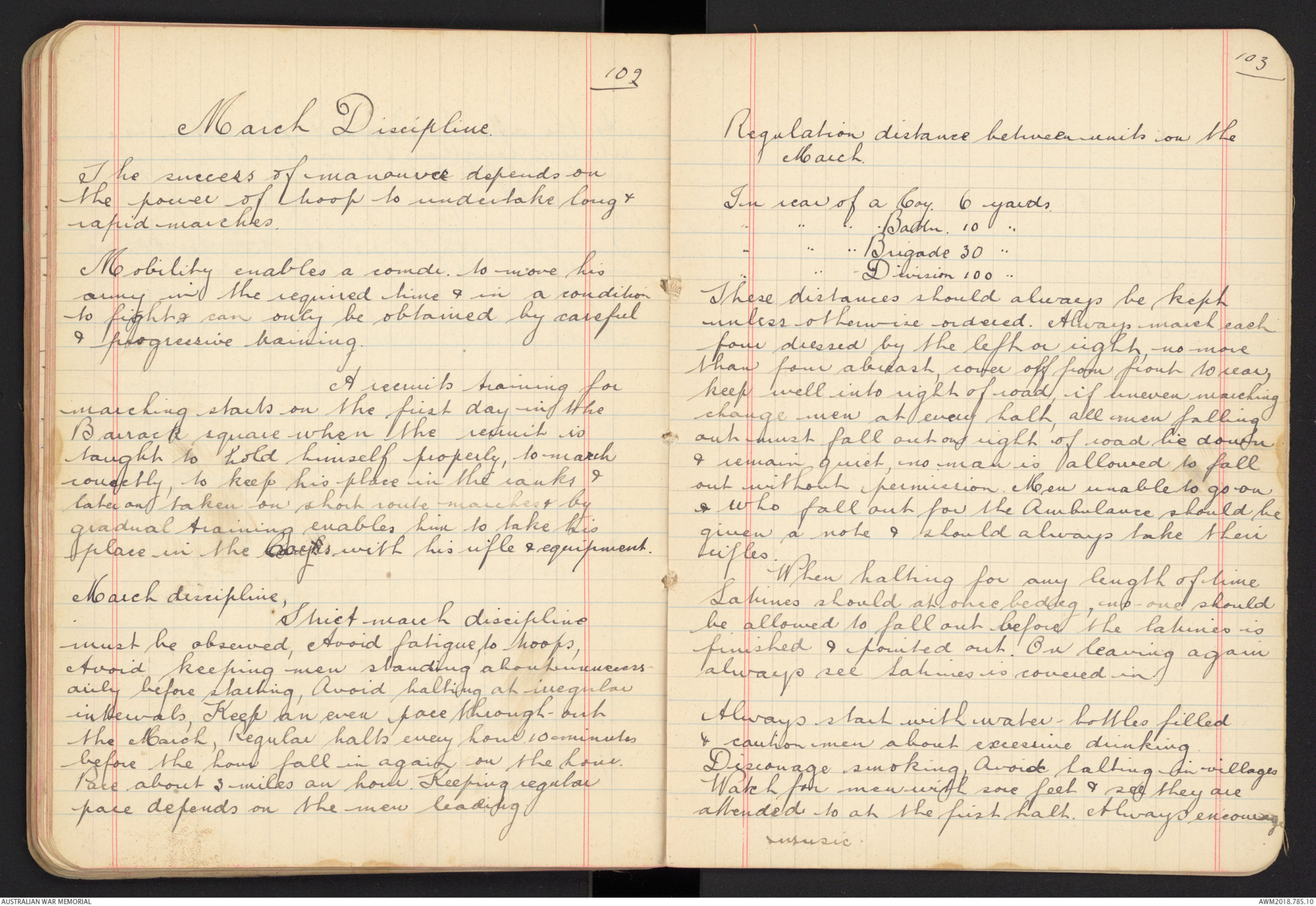
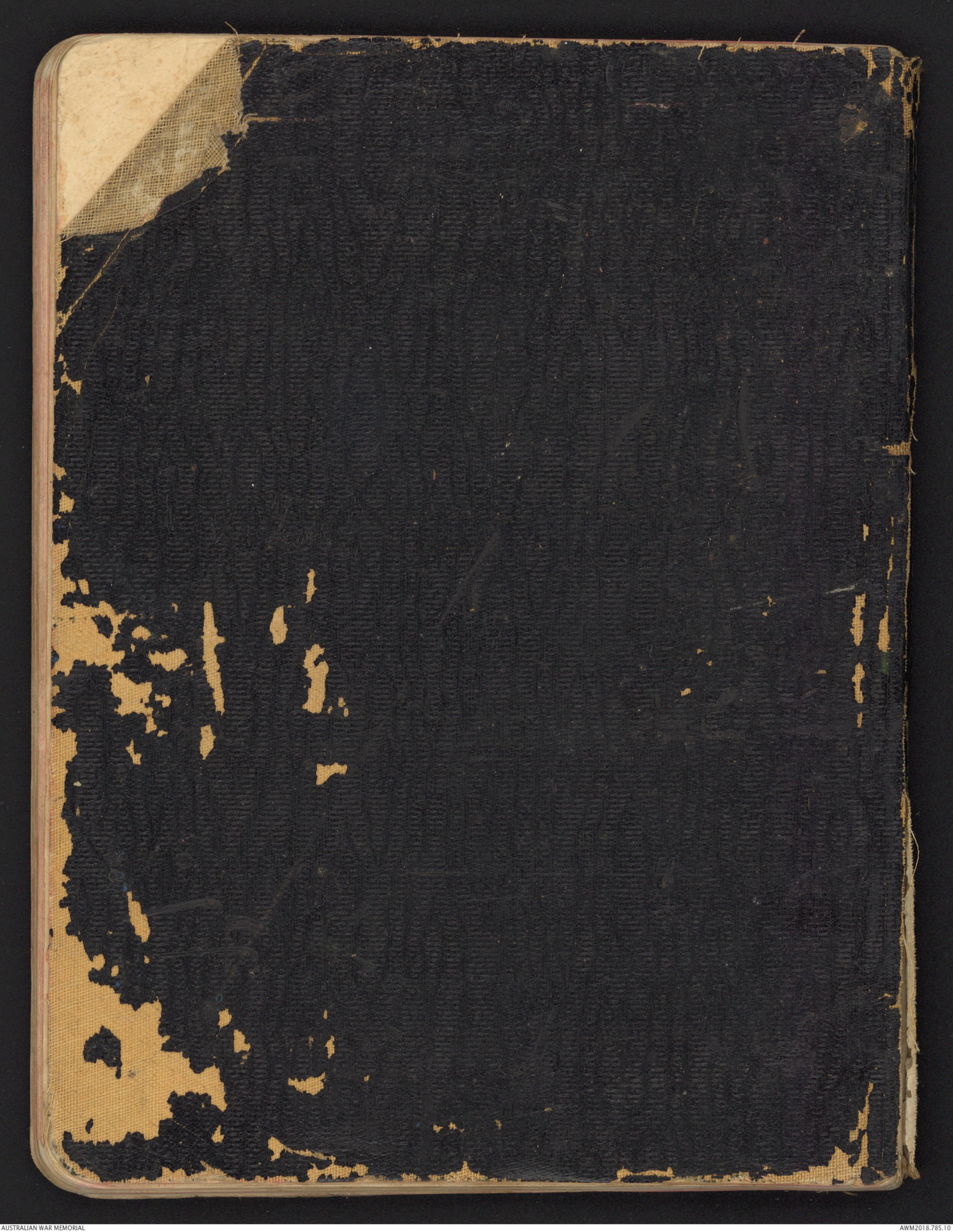
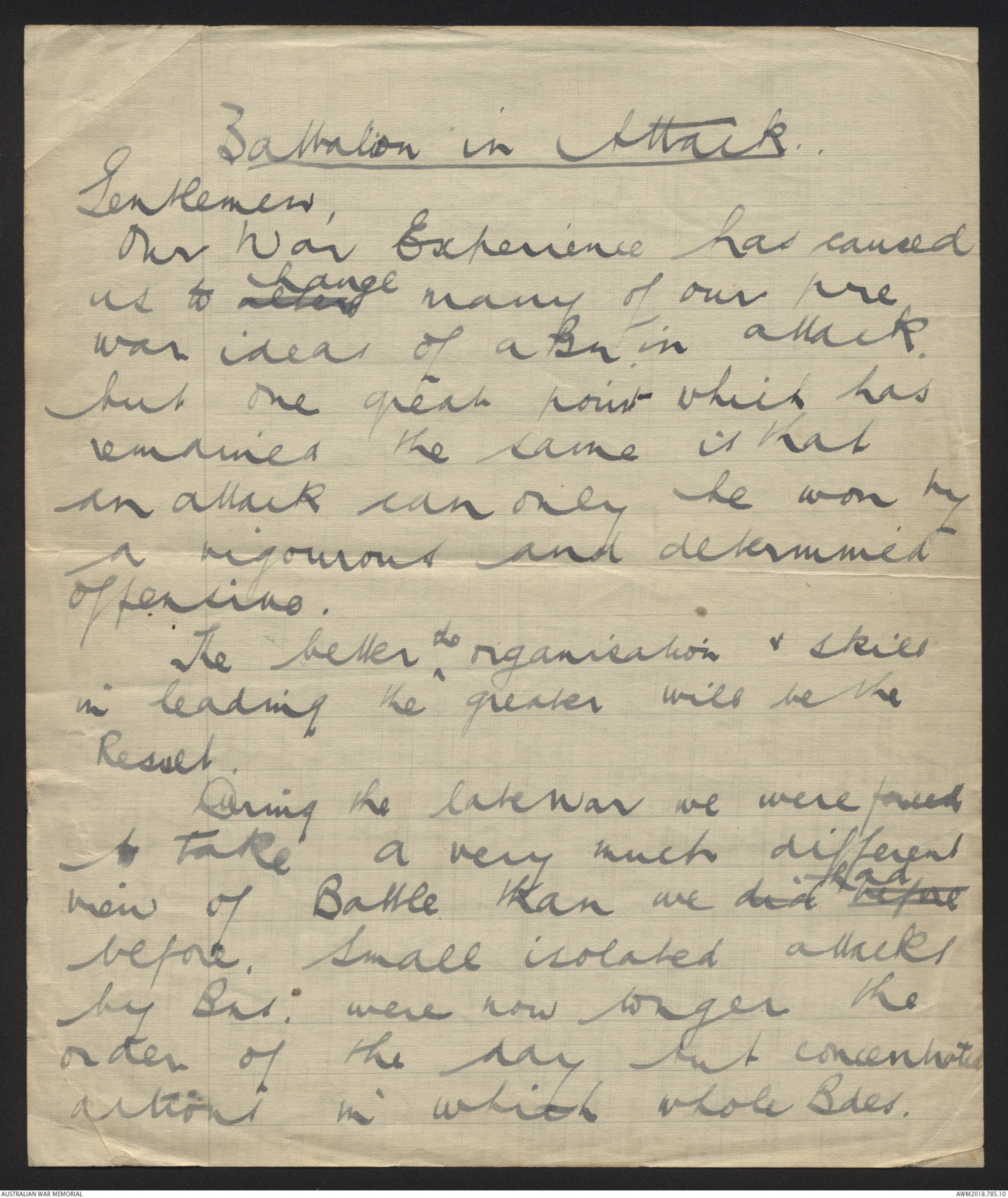
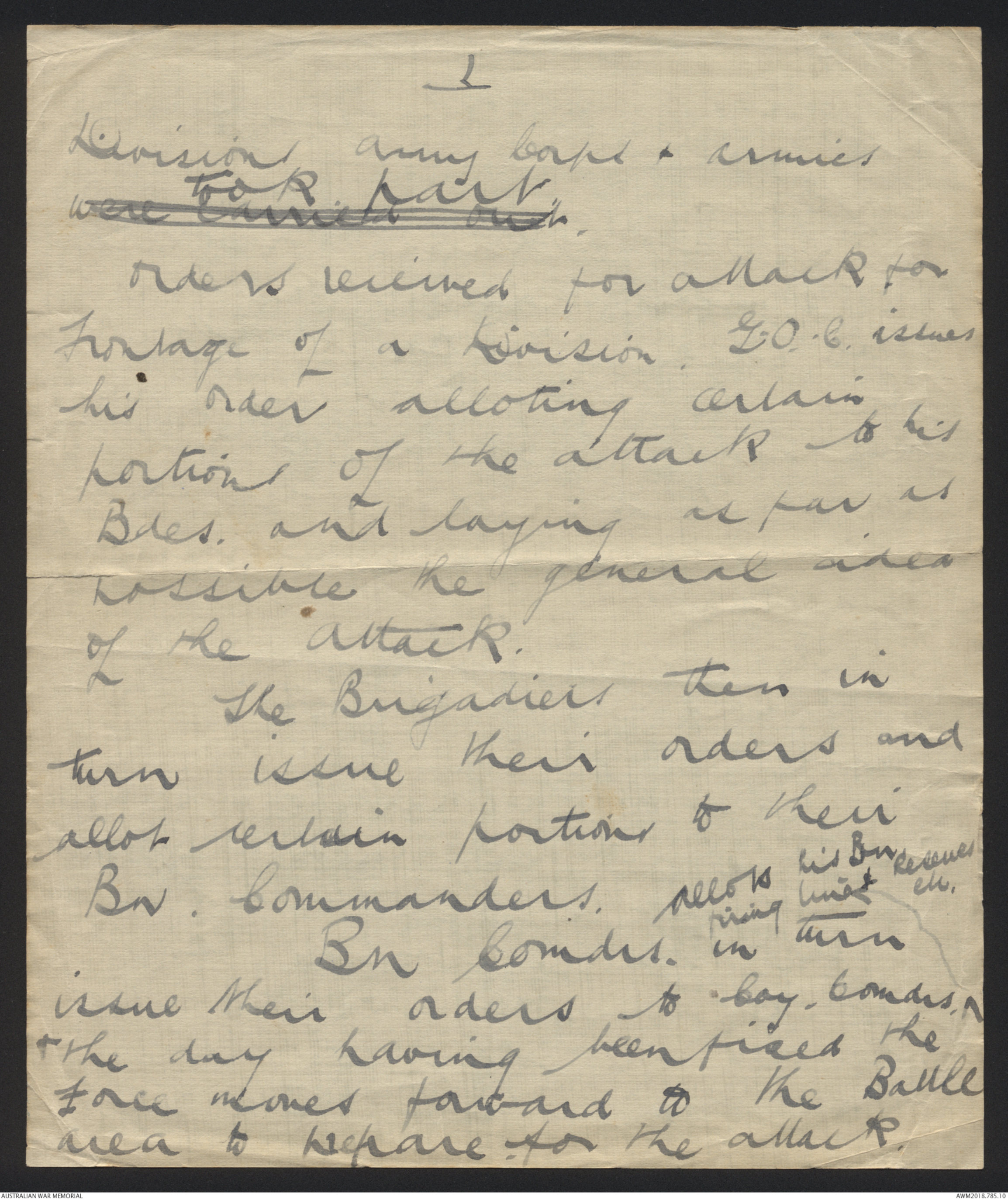
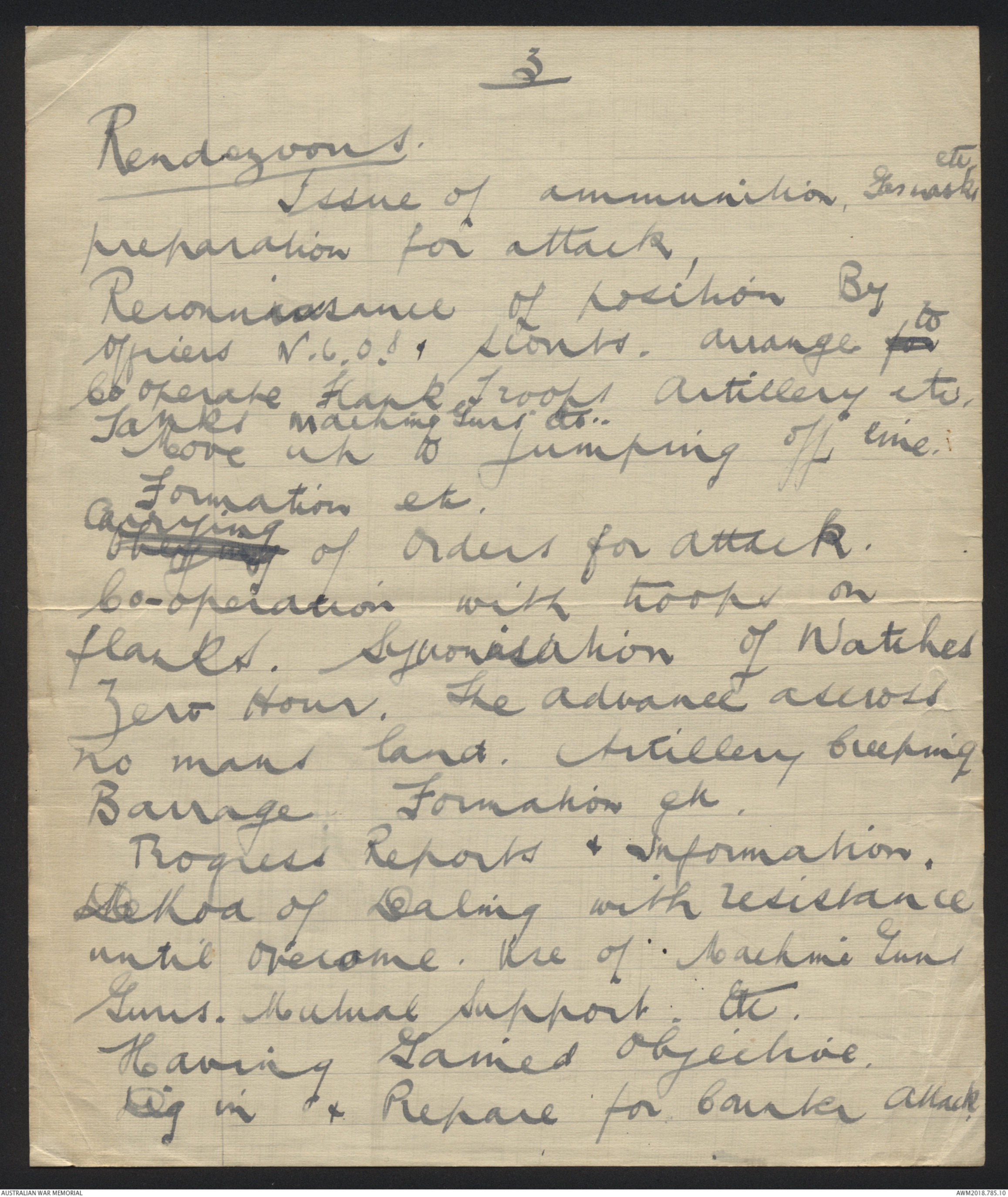
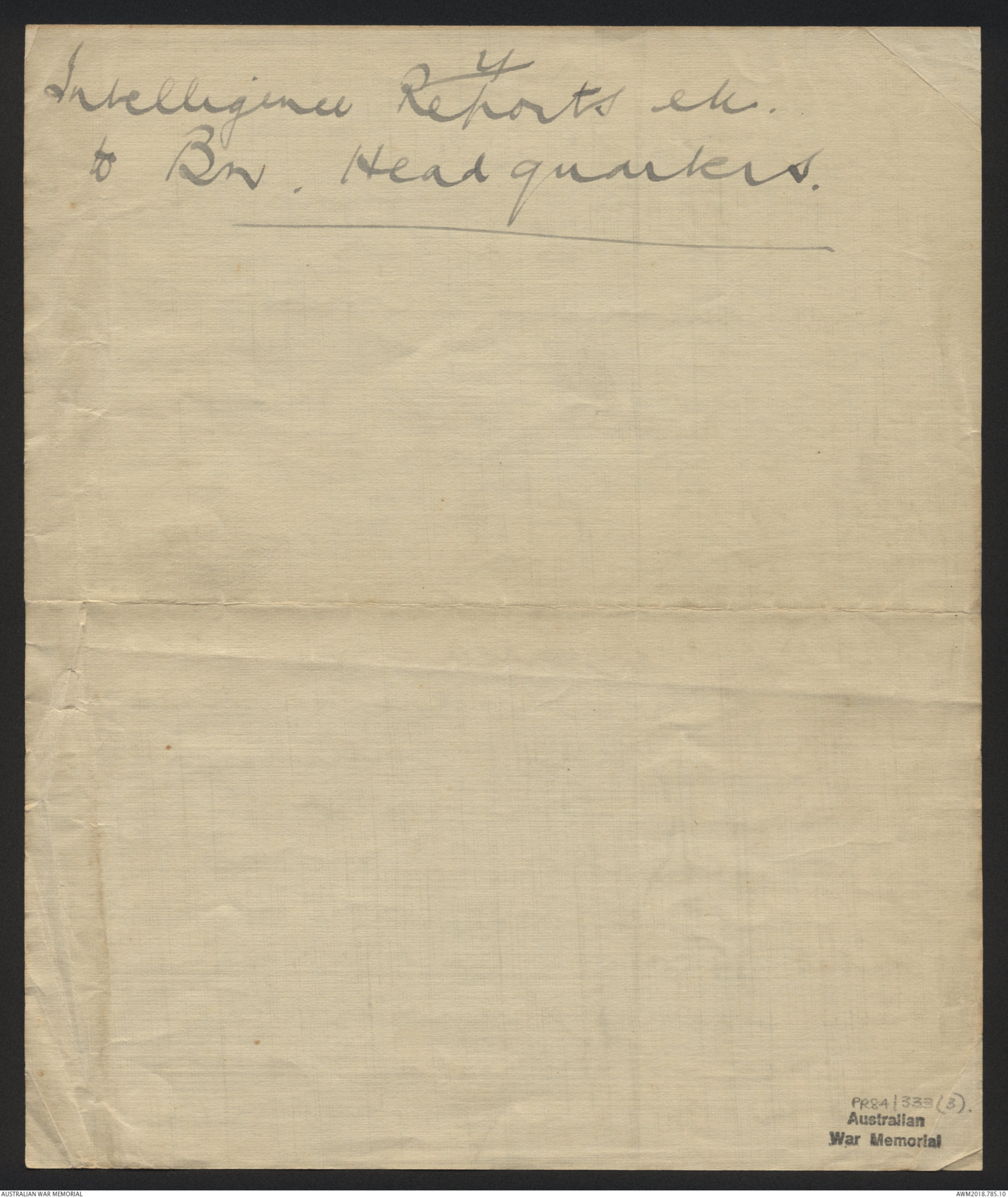
96
Rations.
Rations are issued by the A.S.C. daily.
C.Q. Sgts. make out indent for their Coys.
& hands it to R.Q.M. who in turn makes
out an indent for the Battn. & draws
rations from the A.S.C.
In the field each man carries his own
ration or else it is carried in the cooks
waggon. 1 extra days ration is carried with
the A.S.C. train.
The bread & cheese ration is generally carried
on the man himself.
An extra days ration can be carried by
the men carrying a full days ration
1 days ration in the cooks waggon
& 1 " " in the A.S.C. train.
In addition ^to the daily ration there is also
the iron ration consisting of 1 tin bully
12 ozs biscuits 2 ozs sugar 5/8 oz. of tea ½ oz salt
3 ozs cheese 2 cubes of meat extract. This ration
must be kept intact & will not be opened
unless by the order from the G.O.C
97
Coy. comdrs & Platoon comdrs. should
frequently inspect their men's iron rations.
Care of a Coy.
The Coy. comdr. is responsible for the training
& welfare of his Coy. On taking over new men
Officers should get to know their men individualy.
Rations should always be issued over-night
if possible.
In ordering parades always see
the men are not fallen in too early avoid
keeping men standing about unnecessarily.
Platoon Comdrs. are responsible for their
platoons & must inspect all
rifles, boots, clothing, equipment, ammunition,
iron rations, identity discs, field dressings,
& Gas helmets if carried.
Billetting of troops.
Coy & Platoon comdrs. should go round & see
their platoons are comfortably housed ^before they see
to their own comfort.
All duties must be evenly distributed such
as ration & fatigue parties
98
When on the march water bottles must
be filled if possible over-night, but men
should be warned that it might have to
last all day.
When Coys. are supplying Out-posts on such
duties they must be evenly distributed between
Platoons.
In billetting or bivouac Platoon
& Coy. Officers should all sleep together
& the Coy. comdr. must be where he can be
found by the Adjutant.
Each Coy should
detail two orderleys to report to head-quarters
so if the messages are needed they can be
taken direct to Coys.
99
Trench Warfare.
Reliefs of trenches will usually be carried
out in the night so as to escape observation by
the enemy.
Troops in Billets or bivouac will
usually start of in column of fours & will
be met by guides from the trenches.
Reliefs must take up all possible stores such
as amn. rations, etc Men with the heaviest
loads will march in front & the pace will be
slow.
Once the communication trench troops must
keep well blocked up men keeping in touch
so as not to lose direction.
Men who are to be relieved will have been
warned & will be in the front line of trench.
The new men take up their positions beside
them.
Coy & Platoon comdrs. take over all
stores amn. flares, bombs, etc. & N.C.O's take
over sections.
In handing over all information
must be given, &
Any change in the general situation,
Any unfinished work
Any further work required
Any dangerous spots in the trench
Position of listening posts.
No. of trench also names & nos. of trench on the flank
& support trenches.
98
Sentrys.
At night 1 man to 3 will observe or even
1 to 2 if necessary.
N.C.O's should be made responsible for
the posting of sentries & must see that the
men carry out the duty.
Sentries must have all orders what to do
in case of persons approaching & know where
the sentries are on their right & left.
All bayonets are to be fixed all night.
Two orderlies will be told off to go to Battn.
Head-quarters & may be used for carry messages
if necessary.
In posting sentries N.C.O's must wake the
men a few minutes before it is time for them
to go on.
In addition to sentries there will
listening posts of 2 men sapped out in front.
Reconnoitering Patrols will also be sent out
for observation & reconnaisance.
Coy. Comdrs. will arrange for the use of flares
at intervals so as to see any movement of the
enemy.
99
When enemy flares go up men are to remain
absolutely motionless.
During the day Officers must be on the
lookout for any change or fresh work on
the enemys line & take a note of it.
There must be strict & careful sanitation
in trenches.
All sentries should be warned if reconnoitering
patrols are out in front & should be given
strict orders about challenging.
In trenches gas helmets should always be
kept handy.
All rifles & amn. should be carefully
looked after, all ammunition should be
cleaned once or twice a week.
In trenches discipline must be observed
& common sense used.
100
Trench Attack.
Requires the greatest care & detail in
preliminary arrangements.
Arrangements with Artillery to
1 Engage & silence the enemy's batteries
2 Destruction of the enemy's defence.
3 Support of Infantry Attack.
4 Protect Infantry against counter attack.
Bombardments will be rehearsed & the time
& day for the attack fixed.
The men in the first line do not attack but
the attack is made by fresh troops brought
up from the supports.
Just previous to the attack there will be
a heavy bombardment for 20 minutes
& then 10 minutes interval, then another bombardment
of 20 minutes followed by 4 or 5 min
intense bombardment.
Immediately the bombardment
stops the infantry go forward & make the
assault.
101
As the attack is carried forward the
artillery lengthens the range & builds up a
curtain of fire behind the enemys trenches to
prevent the supports from getting up.
In the meantime the trenches placed
in defence all saps blocked etc.
If trenches are lost at any time there
should be a counter attack.
102
March Discipline.
The success of manouvre depends on
the power of troop to undertake long &
rapid marches.
Mobility enables a comdr. to move his
army in the required time & in a condition
to fight & can only be obtained by careful
& progressive training.
A recruits training for
marching starts on the first day in the
Barrack square when the recruit is
taught to hold himself properly, to march
correctly, to keep his place in the ranks &
later on taken on short route marches & by
gradual training enables him to take his
place in the Coys. with his rifle & equipment.
March discipline,
Strict march discipline
must be observed, Avoid fatigue to troops,
Avoid keeping men standing about unnecessarily
before starting. Avoid halting at irregular
intervals, Keep an even pace through-out
the March, Regular halts every hour 10 minutes
before the hour fall in again on the hour.
Pace about 3 miles an hour. Keeping regular
pace depends on the men leading.
103
Regulation distance between units on the
March.
In rear of a Coy. 6 yards.
" " " " Battn. 10 "
" " " " Brigade 30 "
" " " " Division 100 "
These distances should always be kept
unless otherwise ordered. Always march each
four dressed by the left or right, no more
than four abreast, cover off from front to rear,
keep well into right of road, if uneven marching
change men at every halt, all men falling
out must fall out on right of road lie down
& remain quiet, no man is allowed to fall
out without permission. Men unable to go on
& who fall out for the Ambulance should be
given a note & should always take their
rifles.
When halting for any length of time
Latrines should at once be dug, no-one should
be allowed to fall out before the latrines is
finished & pointed out. On leaving again
always see Latrines is covered in.
Always start with water-bottles filled
& caution men about excessive drinking.
Discourage smoking. Avoid halting in villages.
Watch for men with sore feet & see they are
attended to at the first halt. Always encourage
music.
Battalion in Attack.
Gentlemen,
Our War experience has caused
us to alter change many of our pre
war ideas of a Bn. in attack.
but one great point which has
remained the same is that
an attack can only be won by
a rigorous and determined
offensive.
The better ^the organisation & skill
in leading the greater will be the
Result.
During the late war we were forced
to take a very much different
view of Battle than we did before had
before. Small isolated attacks
by Bns. were now longer the
order of the day but concentrated
actions in which whole Bdes.
2
Divisions Army Corps & Armieswere carried out. took part.
Orders received for attack for
Frontage of a Division. G.O.C. issues
his order alloting certain
portions of the attack to his
Bdes. and laying as far as
possible the general idea
of the attack.
The Brigadiers then in
turn issue their orders and
allot certain portions to their
Bn. Commanders.
Bn. Comdrs. in turn
issue their orders to Coy. Comdrs.
^allots his Bn
firing line & Reserves
etc.
& the day having been fixed the
Force moves forward to the Battle
area to prepare for the attack.
3
Rendezvous.
Issue of ammunition, Gas masks, etc.
preparation for attack,
Reconnaisance of position By
officers N.C.O's & Scouts. Arrange for to
cooperate Flank Troops Artillery etc,
Tanks Machine Guns etc.
Move up to jumping off line.
Formation etc.
Obeying Carrying of Orders for attack.
Co-operation with troops on
flanks. Synchronisation of Watches
Zero Hour. The advance across
no mans land. Artillery Creeping
Barrage Formation etc.
Progress Reports & Information.
Method of dealing with resistance
until overcome. Use of Machine Guns
Guns. Mutual Support. etc.
Having Gained Objective
dig in & Prepare for Counter Attack.
4
Intelligence Reports etc.
to Bn. Headquarters.
PR 84/333(3).
Australian
War Memorial
 H.Boutell
H.BoutellThis transcription item is now locked to you for editing. To release the lock either Save your changes or Cancel.
This lock will be automatically released after 60 minutes of inactivity.